Suppression of Banana Fusarium Wilt Disease with Soil Microbial Mechanisms via Pineapple Rotation and Residue Amendment
Abstract
1. Introduction
2. Materials and Methods
2.1. Pot Rotation Experimental Design
2.2. Pineapple Residue Amendment Pot Experimental Design
2.3. Disease Incidence Determination
2.4. Soil Sampling Collection and DNA Extraction
2.5. Quantitative PCR of Fusarium Oxysporum in Bulk and Rhizosphere Soil
2.6. Soil Chemical Analysis and Culturable Microorganism Determination
2.7. Illumina MiSeq Sequencing and Data Processing
2.8. Statistical Analysis
3. Results
3.1. Effects of Pineapple Rotation and Residue Amendment on Banana Fusarium Wilt Disease Incidence and Relative Abundance of Fusarium
3.2. Effects of Pineapple Rotation and Residue Amendment on Microbial Community Structure
3.3. Effects of Pineapple Rotation and Residue Amendment on Taxonomic Composition
3.4. Bulk and Rhizosphere Network Construction through Effects on Specific Microbial Taxa
3.5. Effects of The F. oxysporum, Microbial Communities, and Key Microorganism on Banana Fusarium Wilt Disease Incidence
4. Discussion
5. Conclusions
Supplementary Materials
Author Contributions
Funding
Institutional Review Board Statement
Informed Consent Statement
Data Availability Statement
Conflicts of Interest
References
- Dita, M.A.; Waalwijk, C.; Buddenhagen, I.W.; Souza, M.T., Jr.; Kema, G.H.J. A molecular diagnostic for tropical race 4 of the banana fusarium wilt pathogen. Plant Pathol. 2010, 59, 348–357. [Google Scholar] [CrossRef]
- Mendes, R.; Garbeva, P.; Rainmakers, J.M. The rhizosphere microbiome: Significance of plant beneficial, plant pathogenic, and human pathogenic microorganisms. FEMS Microbiol. Rev. 2013, 37, 634–663. [Google Scholar] [CrossRef]
- Butler, D. Fungus threatens top banana. Nature 2013, 504, 195–196. [Google Scholar] [CrossRef] [PubMed]
- Mendes, L.W.; Kuramae, E.E.; Navarrete, A.A.; van Veen, J.A.; Tsai, S.M. Taxonomical and functional microbial community selection in soybean rhizosphere. ISME J. 2014, 8, 1577–1587. [Google Scholar] [CrossRef]
- Huang, Y.H.; Wang, R.C.; Li, C.H.; Zuo, C.W.; Wei, Y.R.; Zhang, L.; Yi, G.L. Control of Fusarium wilt in banana with Chinese leek. Eur. J. Plant Pathol. 2012, 134, 87–95. [Google Scholar] [CrossRef]
- Hwang, S.C.; Ko, W.H. Cavendish banana cultivars resistant to Fusarium wilt acquired through somaclonal variation in Taiwan. Plant Dis. 2004, 88, 580–588. [Google Scholar] [CrossRef]
- Abubakar, A.I.; Khairulmazmi, A.; Yasmeen, S.; Muhammad, A.A.W.; Abdulaziz, B.K.; Adamu, A.; Zobir, S.A.M.; Abdu, A.; Abdullah, S.N.A. Fusarium Wilt of Banana: Current Update and Sustainable Disease Control Using Classical and Essential Oils Approaches. Hortic. Plant J. 2022, in press. [Google Scholar] [CrossRef]
- Tao, C.Y.; Li, R.; Xiong, W.; Shen, Z.Z.; Liu, S.S.; Wang, B.B.; Ruan, Y.Z.; Geisen, S.; Shen, Q.R.; Kowalchuk, G.A. Bio-organic fertilizers stimulate indigenous soil Pseudomonas populations to enhance plant disease suppression. Microbiome 2020, 8, 137. [Google Scholar] [CrossRef] [PubMed]
- Zhang, L.; Cenci, A.; Rouard, M.; Zhang, D.; Wang, Y.Y.; Tang, W.H.; Zheng, S.J. Transcriptomic analysis of resistant and susceptible banana corms in response to infection by Fusarium oxysporum f. sp. cubense tropical race 4. Sci. Rep. 2019, 9, 8199. [Google Scholar] [CrossRef]
- Wang, B.B.; Yuan, J.; Zhang, J.; Shen, Z.Z.; Zhang, M.X.; Li, R.; Ruan, Y.Z.; Shen, Q.R. Effects of novel bioorganic fertilizer produced by Bacillus amyloliquefaciens W19 on antagonism of Fusarium wilt of banana. Biol. Fert. Soils 2013, 49, 435–446. [Google Scholar] [CrossRef]
- Sun, J.B.; Zou, L.P.; Li, W.B.; Yang, J.H.; Wang, Y.J.; Xia, Q.Y.; Peng, M. Rhizosphere soil properties and banana fusarium wilt suppression influenced by combined chemical and organic fertilizations. Agric. Ecosyst. Environ. 2018, 254, 60–68. [Google Scholar] [CrossRef]
- Ploetz, R.C.; Churchill, A.C.L. Fusarium wilt: The banana disease that refuses to go away. Acta Hortic. 2011, 897, 519–526. [Google Scholar] [CrossRef]
- Zhang, N.; He, X.; Zhang, J.; Raza, W.; Yang, X.M.; Ruan, Y.Z.; Shen, Q.R.; Huang, Q.W. Suppression of Fusarium wilt of banana with application of bio-organic fertilizers. Pedosphere 2014, 24, 613–624. [Google Scholar] [CrossRef]
- Lakshmanan, P.; Selvaraj, P.; Mohan, S. Efficacy of different methods for the control of Panama disease. Trop. Pest Manag. 2008, 33, 373–374. [Google Scholar] [CrossRef]
- Xue, C.; Shen, Z.Z.; Hao, Y.W.; Yu, S.T.; Li, Y.C.; Huang, W.J.; Chong, Y.; Ran, W.; Li, R.; Shen, Q.R. Fumigation coupled with bio-organic fertilizer for the suppression of watermelon Fusarium wilt disease re-shapes the soil microbiome. Appl. Soil Ecol. 2019, 140, 49–56. [Google Scholar] [CrossRef]
- Li, Y.; Guo, Q.; Wei, X.; Xue, Q.; Lai, H. Biocontrol effects of Penicillium griseofulvum against monkshood (Aconitum carmichaelii Debx.) root diseases caused by Sclerotium rolfsiii and Fusarium spp. J. Appl. Microbiol. 2019, 127, 1532–1545. [Google Scholar] [CrossRef]
- Su, L.X.; Shen, Z.Z.; Ou, Y.N.; Tao, C.Y.; Ruan, Y.Z.; Li, R.; Shen, Q.R. Novel soil fumigation strategy suppressed plant-parasitic nematodes associated with soil nematode community alterations in the field. Appl. Soil Ecol. 2017, 121, 135–142. [Google Scholar] [CrossRef]
- Ploetz, R.C. Management of Fusarium wilt of banana: A review with special reference to tropical race 4. Crop Prot. 2015, 73, 7–15. [Google Scholar] [CrossRef]
- Larkin, R.P. Soil health paradigms and implications for disease management. Annu. Rev. Phytopathol. 2015, 53, 199–221. [Google Scholar] [CrossRef] [PubMed]
- Bonanomi, G.; Lorito, M.; Vinale, F.; Woo, S.L. Organic amendments, beneficial microbes, and soil mcrobiota: Toward a unified framework for disease suppression. Annu. Rev. Phytopathol. 2018, 56, 1–20. [Google Scholar] [CrossRef] [PubMed]
- Li, M.H.; Guo, J.J.; Ren, T.; Luo, G.W.; Shen, Q.R.; Lu, J.W.; Guo, S.W.; Ling, N. Crop rotation history constrains soil biodiversity and multifunctionality relationships. Agric. Ecosyst. Environ. 2021, 319, 107550. [Google Scholar] [CrossRef]
- Christen, O.; Sieling, K. Effect of different preceding crops and crop rotations on yield of Winter Oil-seed rape (Brassica napus L.). J. Agron. Crop Sci. 1995, 174, 265–271. [Google Scholar] [CrossRef]
- Wang, Y.; Xu, J.; Shen, J.; Luo, Y.; Scheu, S.; Ke, X. Tillage, residue burning and crop rotation alter soil fungal community and water-stable aggregation in arable fields. Soil Tillage Res. 2010, 107, 71–79. [Google Scholar] [CrossRef]
- Larkin, R.P.; Halloran, J.M. Management effects of disease-suppressive rotation crops on potato yield and soil-borne disease and their economic implications in potato production. Am. J. Potato Res. 2014, 91, 429–439. [Google Scholar] [CrossRef]
- Wright, P.J.; Falloon, R.E.; Hedderley, D. Different vegetable crop rotations affect soil microbial communities and soil-borne diseases of potato and onion: Literature review and a long-term field evaluation. N. Z. J. Crop Hort. 2014, 43, 85–110. [Google Scholar] [CrossRef]
- Cunfer, B.M.; Buntin, G.D.; Phillips, D.V. Effect of crop rotation on take-all of wheat in double-cropping systems. Plant Dis. 2006, 90, 1161–1166. [Google Scholar] [CrossRef]
- Wei, Z.; Gu, Y.A.; Friman, V.P.; Kowalchuk, G.A.; Jousset, A. Initial soil microbiome composition and functioning predetermine future plant health. Sci. Adv. 2019, 5, eaaw0759. [Google Scholar] [CrossRef]
- Hong, S.; Jv, H.L.; Lu, M.; Wang, B.B.; Zhao, Y.; Ruan, Y.Z. Significant decline in banana Fusarium wilt disease is associated with soil microbiome reconstruction under chilli pepper-banana rotation. Eur. J. Soil Biol. 2020, 97, 103154. [Google Scholar] [CrossRef]
- Bender, S.F.; Wagg, C.; van der Heijden, M.G.A. An underground revolution: Biodiversity and soil ecological engineering for agricultural sustainability. Trends Ecol. Evol. 2016, 31, 440–452. [Google Scholar] [CrossRef]
- Guo, S.; Xiong, W.; Hang, X.N.; Gao, Z.L.; Jiao, Z.X.; Liu, H.J.; Mo, Y.N.; Zhang, N.; Kowalchuk, G.A.; Li, R.; et al. Protists as main indicators and determinants of plant performance. Microbiome 2021, 9, 64. [Google Scholar] [CrossRef]
- Ge, A.H.; Liang, Z.H.; Xiao, J.L.; Zhang, Y.; Zeng, Q.; Xiong, C.; Han, L.L.; Wang, J.T.; Zhang, L.M. Microbial assembly and association network in watermelon rhizosphere after soil fumigation for Fusarium wilt control. Agric. Ecosyst. Environ. 2021, 312, 107336. [Google Scholar] [CrossRef]
- Lambers, H.; Mougel, C.; Jailard, M.; Hinsinger, P. Plant-microbe-soil interactions in the rhizosphere: An evolutionary perspective. Plant Soil. 2009, 321, 83–115. [Google Scholar] [CrossRef]
- Mcdonald, G.K.; Peck, D. Effects of crop rotation, residue retention and sowing time on the incidence and survival of ascochyta blight and its effect on grain yield of field peas (pisum sativum l.). Field Crop Res. 2009, 111, 11–21. [Google Scholar] [CrossRef]
- Kerdraon, L.; Laval, V.; Suffert, F. Microbiomes and Pathogen Survival in Crop Residues, an Ecotone Between Plant and Soil. Phytobiomes J. 2019, 3, 246–255. [Google Scholar] [CrossRef]
- Hu, L.F.; Robert, C.A.M.; Cadot, S.; Zhang, X.; Ye, M.; Li, B.B.; Manzo, D.; Chervet, N.; Steinger, T.; van der Heijden, M.G.A.; et al. Root exudate metabolites drive plant-soil feedbacks on growth and defense by shaping the rhizosphere microbiota. Nat. Commun. 2018, 9, 2738. [Google Scholar] [CrossRef]
- Yuan, J.; Zhao, J.; Wen, T.; Zhao, M.; Li, R.; Goossens, P.; Huang, Q.W.; Bai, Y.; Vivanco, J.M.; Kowalchuk, G.A.; et al. Root exudates drive the soil-borne legacy of aboveground pathogen infection. Microbiome 2018, 6, 156. [Google Scholar] [CrossRef]
- Zhou, G.; Gao, S.; Lu, Y.; Liao, Y.; Nie, J.; Cao, W. Co-incorporation of green manure and rice straw improves rice production, soil chemical, biochemical and microbiological properties in a typical paddy field in southern China. Soil Tillage Res. 2020, 197, 104499. [Google Scholar] [CrossRef]
- Wang, M.; Pendall, E.; Fang, C.; Li, B.; Nie, M. A global perspective on agroecosystem nitrogen cycles after returning crop residue. Agric. Ecosyst. Environ. 2018, 266, 49–54. [Google Scholar] [CrossRef]
- Martinez-Feria, R.A.; Castellano, M.J.; Dietzel, R.N.; Helmers, M.J.; Liebman, M.; Huber, I.; Archontoulis, S.V. Linking crop- and soil-based approaches to evaluate system nitrogen-use efficiency and tradeoffs. Agric. Ecosyst. Environ. 2018, 256, 131–143. [Google Scholar] [CrossRef]
- Chen, J.; Heiling, M.; Resch, C.; Mbaye, M.; Gruber, R.; Dercon, G. Does maize and legume crop residue mulch matter in soil organic carbon sequestration? Agric. Ecosyst. Environ. 2018, 265, 123–131. [Google Scholar] [CrossRef]
- Afshan, S.; Ali, S.; Bharwana, S.A.; Rizwan, M.; Farid, M.; Abbas, F.; Ibrahim, M.; Mehmood, M.A.; Abbasi, G.H. Citric acid enhances the phytoextraction of chromium, plant growth, and photosynthesis by alleviating the oxidative damages in Brassica napus L. Environ. Sci. Pollut. Res. 2015, 22, 11679–11689. [Google Scholar] [CrossRef] [PubMed]
- De, C.U.; Patruno, L.; Avella, N.; Salimbeni, R.; Lacolla, G.; Cucci, G.; Crecchio, C. Soil management under tomato-wheat rotation increases the suppressive response against Fusarium wilt and tomato shoot growth by changing the microbial composition and chemical parameters. Appl. Soil Ecol. 2020, 154, 103601. [Google Scholar]
- Wang, B.B.; Li, R.; Ruan, Y.Z.; Ou, Y.N.; Zhao, Y.; Shen, Q.R. Pineapple-banana rotation reduced the amount of Fusarium oxysporum more than maize-banana rotation mainly through modulating fungal communities. Soil Biol. Biochem. 2015, 86, 77–86. [Google Scholar] [CrossRef]
- Yang, J.M.; Ren, X.Y.; Liu, M.Y.; Fan, P.S.; Ruan, Y.Z.; Zhao, Y.; Wang, B.B.; Li, R. Suppressing soil-borne Fusarium pathogens of bananas by planting different cultivars of pineapples, with comparisons of the resulting bacterial and fungal communities. Appl. Soil Ecol. 2022, 169, 104211. [Google Scholar] [CrossRef]
- Fierer, N.; Jackson, J.A.; Vilgalys, R.; Jackson, R.B. Assessment of soil microbial community structure by use of taxon-specific quantitative PCR assays. Appl. Environ. Microbiol. 2005, 71, 4117–4120. [Google Scholar] [CrossRef]
- Shen, Z.Z.; Xue, C.; Penton, C.R.; Thomashow, L.S.; Zhang, N.; Wang, B.B.; Ruan, Y.Z.; Li, R.; Shen, Q.R. Suppression of banana Panama disease induced by soil microbiome reconstruction through an integrated agricultural strategy. Soil Biol. Biochem. 2019, 128, 164–174. [Google Scholar] [CrossRef]
- Xiong, W.; Guo, S.; Jousset, A.; Zhao, Q.Y.; Wu, H.S.; Li, R.; Kowalchuk, G.A.; Shen, Q.R. Bio-fertilizer application induces soil suppressiveness against Fusarium wilt disease by reshaping the soil microbiome. Soil Biol. Biochem. 2017, 114, 238–247. [Google Scholar] [CrossRef]
- Liu, L.L.; Kong, J.J.; Cui, H.L.; Zhang, J.B.; Wang, F.H.; Cai, Z.C.; Huang, X.Q. Relationships of decomposability and C/N ratio in different types of organic matter with suppression of Fusarium oxysporum and microbial communities during reductive soil disinfestation. Biol. Control 2016, 101, 103–113. [Google Scholar] [CrossRef]
- Shen, Z.Z.; Ruan, Y.Z.; Wang, B.B.; Zhong, S.T.; Su, L.X.; Li, R.; Shen, Q.R. Effect of biofertilizer for suppressing Fusarium wilt disease of banana as well as enhancing microbial and chemical properties of soil under greenhouse trial. Appl. Soil Ecol. 2015, 93, 111–119. [Google Scholar] [CrossRef]
- Shen, Z.Z.; Ruan, Y.Z.; Xue, C.; Zhong, S.T.; Li, R.; Shen, Q.R. Soils naturally suppressive to banana Fusarium wilt disease harbor unique bacterial communities. Plant Soil. 2015, 393, 21–33. [Google Scholar] [CrossRef]
- Shen, Z.Z.; Xue, C.; Taylor, P.W.J.; Ou, Y.N.; Wang, B.B.; Zhao, Y.; Ruan, Y.Z.; Li, R.; Shen, Q.R. Soil pre-fumigation could effectively improve the disease suppressiveness of biofertilizer to banana Fusarium wilt disease by reshaping the soil microbiome. Biol. Fert. Soils 2018, 54, 793–806. [Google Scholar] [CrossRef]
- Caporaso, J.G.; Kuczynski, J.; Stombaugh, J.; Bittinger, K.; Bushman, F.D.; Costello, E.K.; Fierer, N.; Peña, A.G.; Goodrich, J.K.; Gordon, J.I.; et al. QIIME allows analysis of high-throughput community sequencing data. Nat. Methods 2010, 7, 335–336. [Google Scholar] [CrossRef]
- Edgar, R.C.; Haas, B.J.; Clemente, J.C.; Quince, C.; Knight, R. UCHIME improves sensitivity and speed of chimera detection. Bioinformatics 2011, 27, 2194–2200. [Google Scholar] [CrossRef] [PubMed]
- Wang, Q.; Garrity, G.M.; Tiedje, J.M.; Cole, J.R. Naive Bayesian classifier for rapid assignment of rRNA sequences into the new bacterial taxonomy. Appl. Environ. Microbiol. 2007, 73, 5261–5267. [Google Scholar] [CrossRef]
- Kõljalg, U.; Nilsson, R.H.; Abarenkov, K.; Tedersoo, L.; Taylor, A.F.S.; Bahram, M.; Bates, S.T.; Bruns, T.D.; Bengtsson-Palme, J.; Callaghan, T.M.; et al. Towards a unified paradigm for sequence-based identification of fungi. Mol. Ecol. 2013, 22, 5271–5277. [Google Scholar] [CrossRef]
- R Core Team. R: A Language and Environmentfor Statistical Computing; R Foundation for Statistical Computing: Vienna, Austria, 2019; Available online: https://www.R-project.org/ (accessed on 15 May 2021).
- Oksanen, J.; Blanchet, F.G.; Kindt, R.; Legendre, P.; Minchin, P.R.; O’Hara, R.B. Vegan: Community Ecology Package. R Package ed Version 2.4. 2012. Available online: http://cran.r-project.org/package=vegan (accessed on 20 May 2021).
- Shen, Z.Z.; Penton, C.R.; Lv, N.N.; Xue, C.; Yuan, X.F.; Ruan, Y.Z.; Li, R.; Shen, Q.R. Banana Fusarium wilt disease incidence is influenced by shifts of soil microbial communities under different monoculture spans. Microbiol. Ecol. 2018, 75, 739–750. [Google Scholar] [CrossRef] [PubMed]
- Chen, Y.; Bonkowshi, M.; Shen, Y.; Griffiths, B.S.; Jiang, Y.J.; Wang, X.Y.; Sun, B. Root ethylene mediates rhizosphere microbial community reconstruction when chemically detecting cyanide produced by neighbouring plants. Microbiome 2020, 8, 4. [Google Scholar] [CrossRef] [PubMed]
- Fan, P.S.; Lai, C.Y.; Yang, J.M.; Hong, S.; Yang, Y.; Wang, Q.; Wang, B.; Zhang, R.; Jia, Z.; Zhao, Y.; et al. Crop rotation suppresses soil-borne Fusarium wilt of banana and alters microbial communities. Arch. Agron. Soil Sci. 2022, 68, 447–459. [Google Scholar] [CrossRef]
- Fang, X.L.; You, M.P.; Barbetti, M.J. Reduced severity and impact of Fusarium wilt on strawberry by manipulation of soil pH, soil organic amendments and crop rotation. Eur. J. Plant Pathol. 2012, 134, 619–629. [Google Scholar] [CrossRef]
- Hao, W.Y.; Ren, L.X.; Ran, W.; Shen, Q.R. Allelopathic effects of root exudates from watermelon and rice plants on Fusarium oxysporum f. sp. niveum. Plant Soil. 2010, 336, 485–497. [Google Scholar] [CrossRef]
- Yin, C.T.; Casa Vargas, J.M.; Schlatter, D.C.; Hagerty, C.H.; Hulbert, S.H.; Paulitz, T.C. Rhizosphere community selection reveals bacteria associated with reduced root disease. Microbiome 2021, 9, 1–18. [Google Scholar] [CrossRef]
- Wang, B.B.; Sun, M.Z.; Yang, J.M.; Shen, Z.Z.; Ou, Y.N.; Fu, L.; Zhao, Y.; Li, R.; Ruan, Y.Z.; Shen, Q.R. Inducing banana Fusarium wilt disease suppression through soil microbiome reshaping by pineapple–banana rotation combined with biofertilizer application. Soil 2022, 8, 17–29. [Google Scholar] [CrossRef]
- Yang, J.M.; Duan, Y.J.; Liu, X.Y.; Sun, M.Z.; Wang, Y.M.; Liu, M.Y.; Zhu, Z.Q.; Shen, Z.Z.; Gao, W.; Wang, B.B.; et al. Reduction of banana fusarium wilt associated with soil microbiome reconstruction through green manure intercropping. Agric. Ecosyst. Environ. 2022, 337, 108065. [Google Scholar] [CrossRef]
- Hong, S.; Jv, H.L.; Yuan, X.F.; Geng, J.J.; Wang, B.B.; Zhao, Y.; Wang, Q.; Li, R.; Jia, Z.J.; Ruan, Y.Z. Soil Organic Nitrogen Indirectly Enhances Pepper-Residue-Mediated Soil Disease Suppression through Manipulation of Soil Microbiome. Agronomy 2022, 12, 2077. [Google Scholar] [CrossRef]
- Bahramian, D.; Naraghi, L.; Heydari, A. Effectiveness of the chemical stabilizers of talaromyces flavus in biological control of tomato and greenhouse cucumber vascular wilt disease. J. Plant Prot. Res. 2016, 56, 291–297. [Google Scholar] [CrossRef]
- Xiong, W.; Li, R.; Ren, Y.; Zhao, Q.Y.; Wu, H.S.; Jousset, A.; Shen, Q.R. Distinct roles for soil fungal and bacterial communities associated with the suppression of vanilla Fusarium wilt disease. Soil Biol. Biochem. 2017, 107, 198–207. [Google Scholar] [CrossRef]
- Zhalnina, K.; Louie, K.B.; Hao, Z.; Mansoori, N.; da Rocha, U.N.; Shi, S.J.; Cho, H.; Karaoz, U.; Loqué, D.; Bowen, B.P.; et al. Dynamic root exudate chemistry and microbial substrate preferences drive patterns in rhizosphere microbial community assembly. Nat. Microbiol. 2018, 3, 470–480. [Google Scholar] [CrossRef] [PubMed]
- Su, L.X.; Ruan, Y.Z.; Yang, X.J.; Wang, K.; Li, R.; Shen, Q.R. Suppression on plant-parasitic nematodes using a soil fumigation strategy based on ammonium bicarbonate and its effects on the nematode community. Sci. Rep.-UK 2015, 5, 17597. [Google Scholar] [CrossRef]
- Ling, N.; Wang, T.T.; Kuzyakov, Y. Rhizosphere bacteriome structure and functions. Nat. Commun. 2022, 13, 836. [Google Scholar] [CrossRef]
- Shen, Z.Z.; Zhong, S.T.; Wang, Y.G.; Wang, B.B.; Mei, X.L.; Li, R.; Ruan, Y.Z.; Shen, Q.R. Induced soil microbial suppression of banana fusarium wilt disease using compost and biofertilizers to improve yield and quality. Eur. J. Soil Biol. 2013, 57, 1–8. [Google Scholar] [CrossRef]
- Tian, B.N.; Xie, J.T.; Fu, Y.P.; Cheng, J.S.; Li, B.; Chen, T.; Zhao, Y.; Gao, Z.X.; Yang, P.Y.; Barbetti, M.J.; et al. A cosmopolitan fungal pathogen of dicots adopts an endophytic lifestyle on cereal crops and protects them from major fungal diseases. ISME J. 2020, 14, 3120–3135. [Google Scholar] [CrossRef] [PubMed]
- Steensels, J.; Gallone, B.; Voordeckers, K.; Verstrepen, K.J. Domestication of industrial microbes. Curr Biol. 2019, 29, R381–R393. [Google Scholar] [CrossRef]
- Zhai, M.M.; Niu, H.T.; Li, N.; Xiao, H.; Shi, Y.P.; Di, D.L.; Crews, P.; Wu, Q.X. Talaromycolides A–C, Novel Phenyl-Substituted Phthalides Isolated from the Green Chinese Onion-Derived Fungus Talaromyces pinophilus AF-02. J. Agric. Food Chem. 2015, 63, 9558–9564. [Google Scholar] [CrossRef]
- Naraghi, L.; Heydari, A.; Rezaee, S.; Razavi, M.; Khaledi, E.M. Biological control of tomato verticillium wilt disease by talaromyces flavus. J. Plant Prot. Res. 2010, 50, 360–365. [Google Scholar] [CrossRef]
- Moreno, A.B.; Penas, G.; Rufat, M.; Bravo, J.M.; Estopà, M.; Messeguer, J.; Segundo, B.S. Pathogen-induced production of the antifungal AFP protein from Aspergillus giganteus confers resistance to the blast fungus Magnaporthe grisea in transgenic rice. Mol. Plant-Microbe Interact. 2005, 18, 951–960. [Google Scholar] [CrossRef] [PubMed]
- Wu, H.M.; Lin, M.H.; Rensing, C.; Qin, X.J.; Zhang, S.k.; Chen, J.; Wu, L.K.; Zhao, Y.L.; Lin, S.; Lin, W.X. Plant-mediated rhizospheric interactions in intraspecific intercropping alleviate the replanting disease of Radix pseudostellariae. Plant Soil 2020, 454, 411–430. [Google Scholar] [CrossRef]
- Yuan, X.F.; Hong, S.; Xiong, W.; Raza, W.; Shen, Z.Z.; Wang, B.B.; Li, R.; Ruan, Y.Z.; Shen, Q.R.; Dini-Andreote, F. Development of fungal-mediated soil suppressiveness against Fusarium wilt disease via plant residue manipulation. Microbiome 2021, 9, 200. [Google Scholar] [CrossRef]
- Yuan, X.F.; Wang, B.B.; Hong, S.; Xiong, W.; Shen, Z.Z.; Ruan, Y.Z.; Li, R.; Shen, Q.R.; Dini-Andreote, F. Promoting soil microbial-mediated suppressiveness against Fusarium wilt disease by the enrichment of specifc fungal taxa via crop rotation. Biol. Fert. Soils. 2021, 57, 1137–1153. [Google Scholar] [CrossRef]
- Baileya, K.L.; Lazarovitsb, G. Suppressing soil-borne diseases with residue management and organic amendments. Soil Tillage Res. 2003, 72, 169–180. [Google Scholar] [CrossRef]
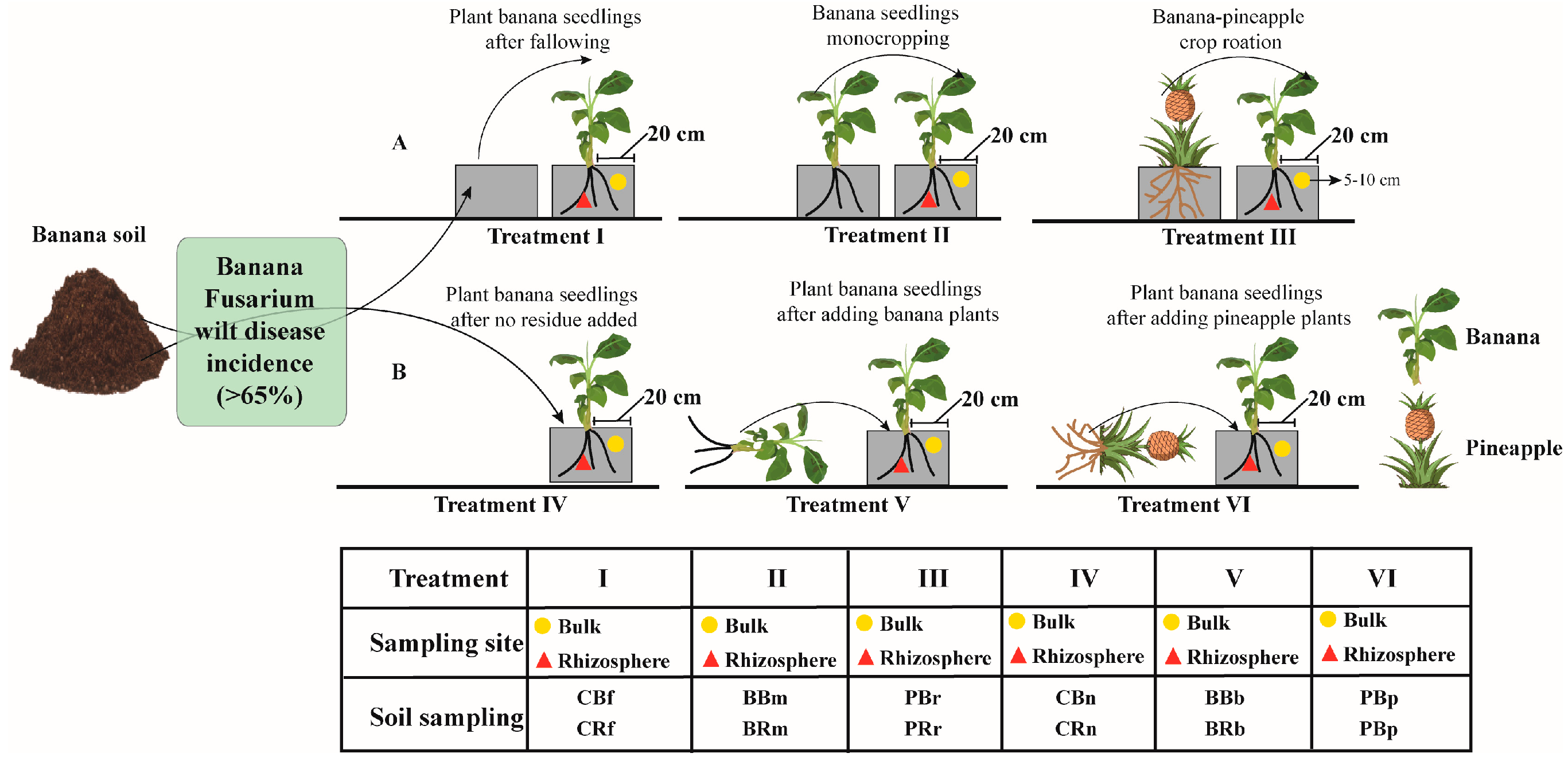
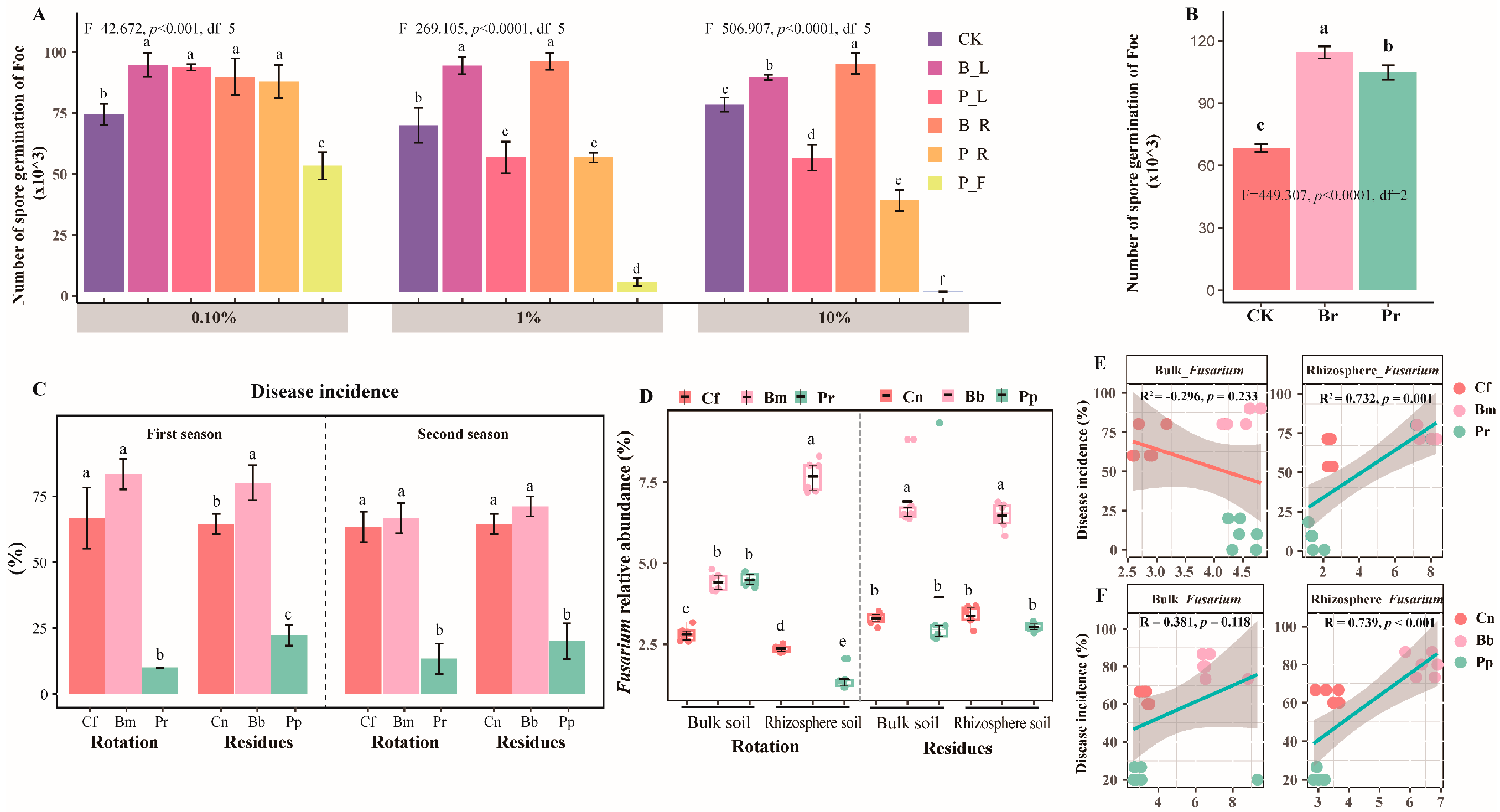
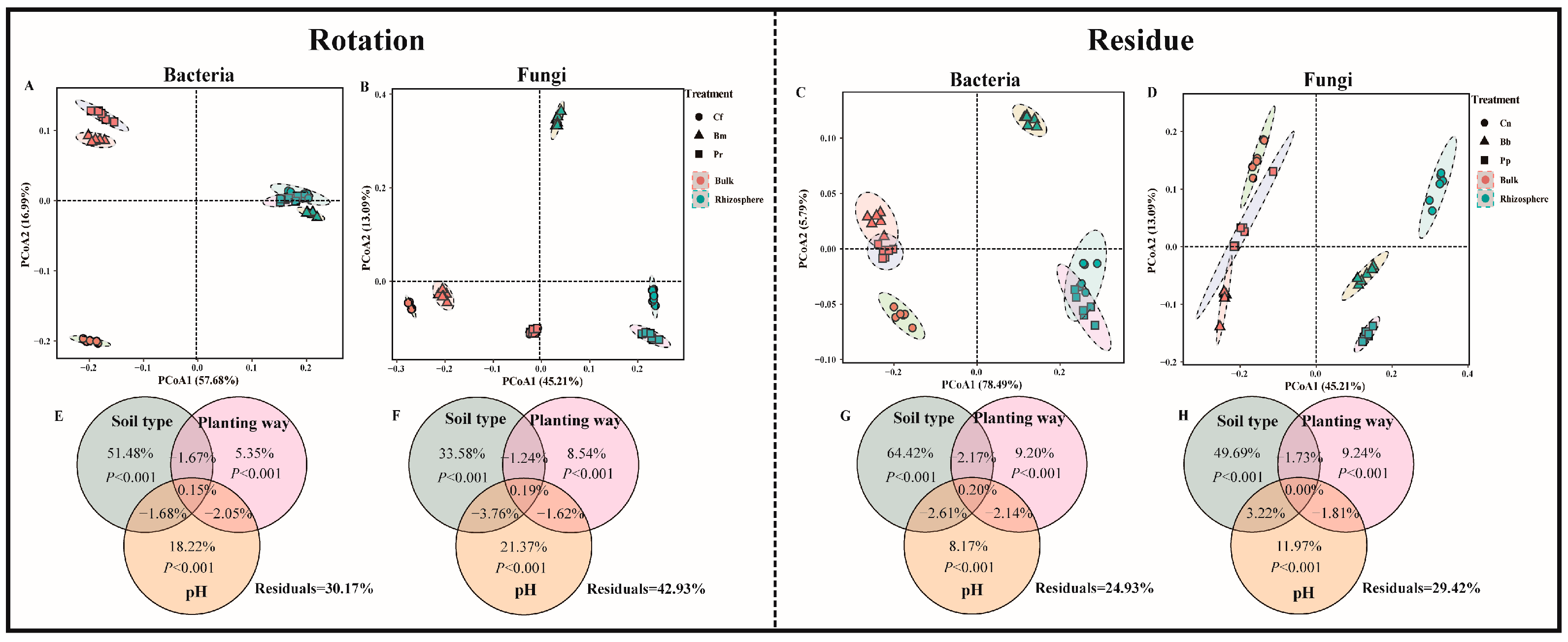
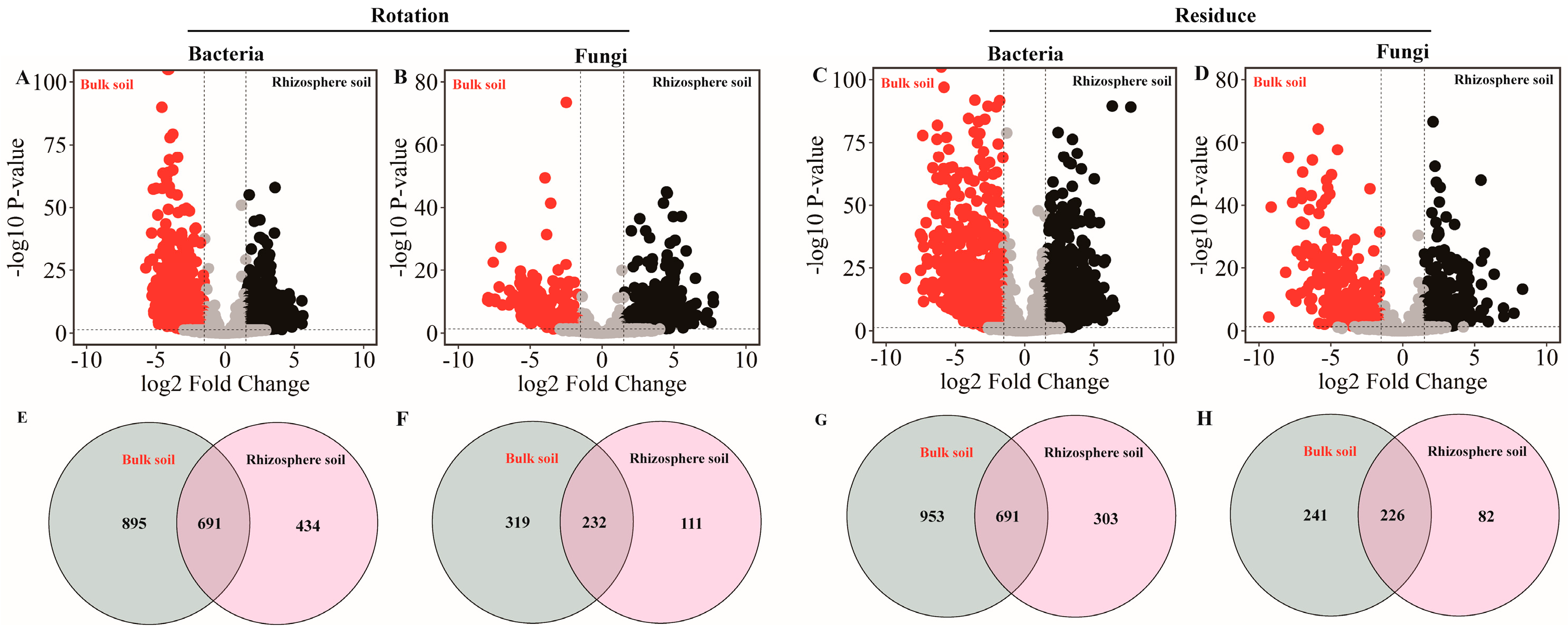
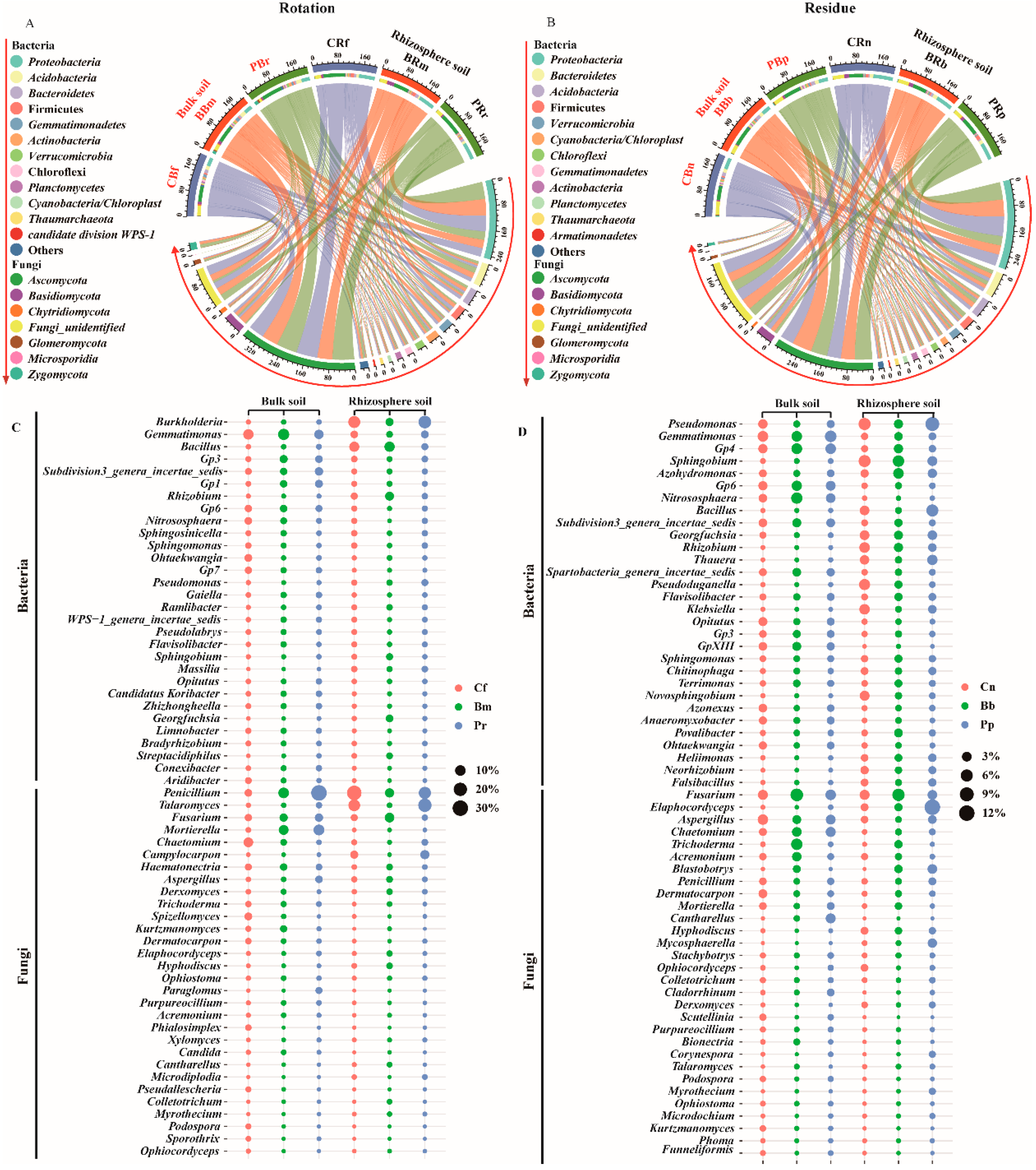
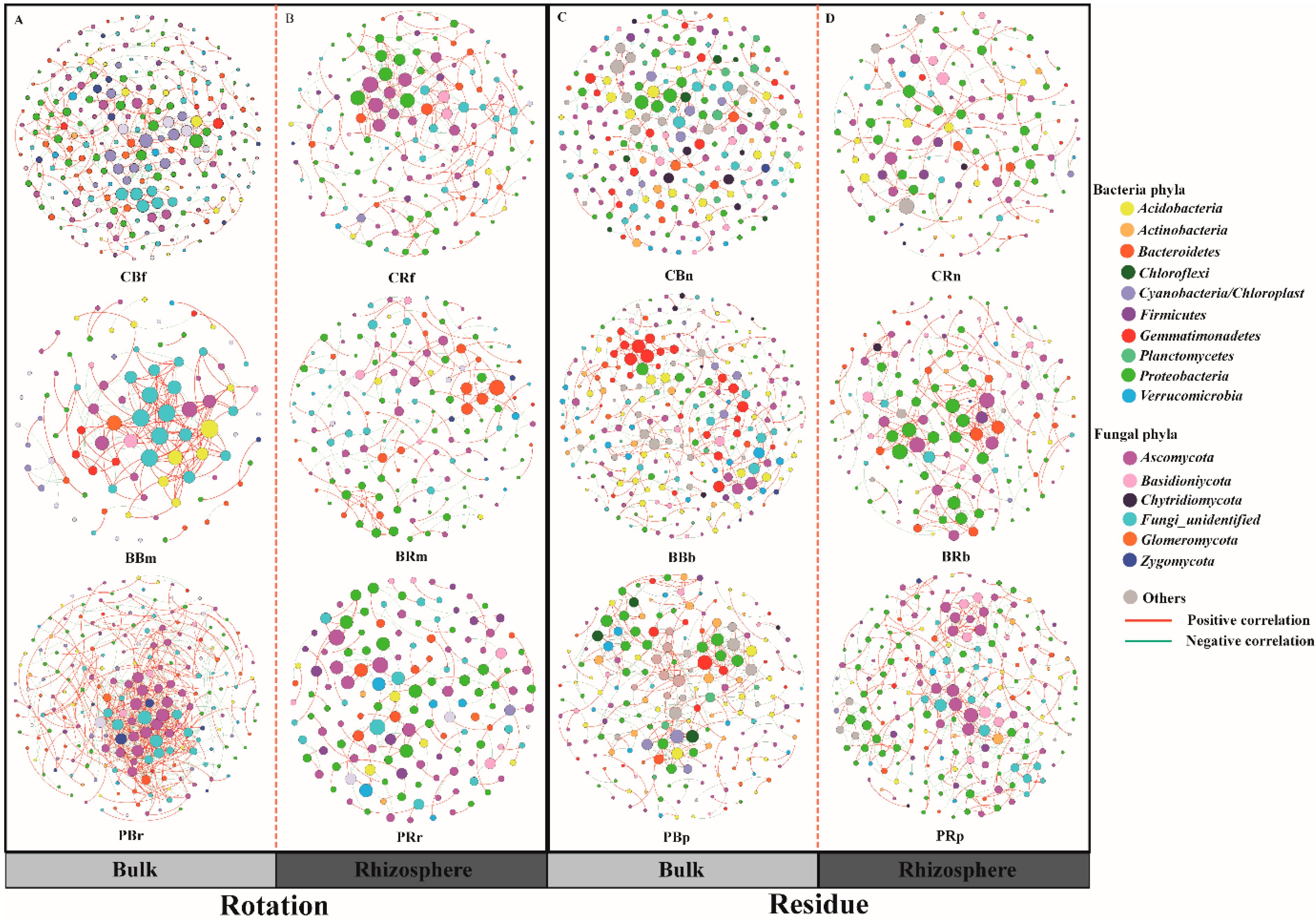
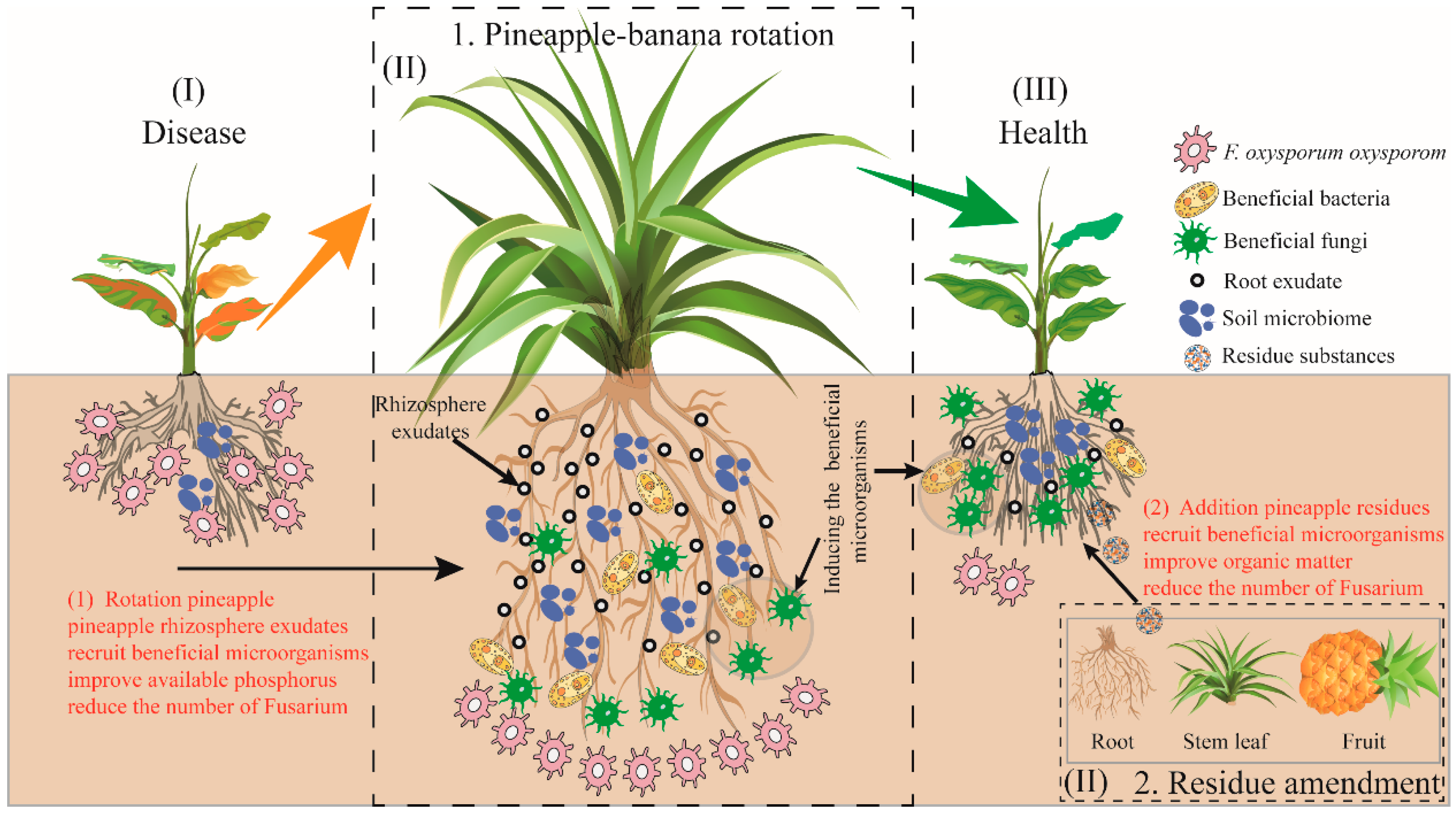
| Crop Rotation | df | F | p | r | Relative Importance | Residue Amendment | df | F | p | r | Relative Importance |
|---|---|---|---|---|---|---|---|---|---|---|---|
| Bacterial-pcoa1 (bulk) | 1 | 2.35 | 0.159 | 2.06 | 4.19% | F.oxysporum (bulk) | 1 | 154.60 | 0.000 | 2.33 | 6.44% |
| Fungal-pcoa1 (rhizosphere) | 1 | 23.41 | 0.001 | −2.47 | 10.89% | F.oxysporum (rhizosphere) | 1 | 91.47 | 0.000 | 2.27 | 7.95% |
| F.oxysporum (rhizosphere) | 1 | 278.24 | 0.000 | 2.05 | 7.73% | Fusarium relative abundance (rhizosphere) | 1 | 363.96 | 0.000 | 2.55 | 25.49% |
| Fusarium relative abundance (bulk) | 1 | 68.97 | 0.000 | −1.80 | 6.62% | Fungal-pcoa1 (bulk) | 1 | 1.89 | 0.203 | −1.50 | 6.78% |
| Fusarium relative abundance (rhizosphere) | 1 | 201.74 | 0.000 | −3.36 | 12.70% | Pseudomonas (bulk) | 1 | 98.76 | 0.000 | 2.70 | 4.85% |
| Burkholderia (rhizosphere) | 1 | 3.56 | 0.029 | −2.22 | 13.79% | Penicillium (bulk) | 1 | 5.06 | 0.051 | −1.48 | 3.48% |
| Talaromyces (bulk) | 1 | 64.32 | 0.000 | −3.52 | 23.61% | Aspergillus (bulk) | 1 | 28.96 | 0.000 | 1.64 | 3.01% |
| Talaromyces (rhizosphere) | 1 | 1.41 | 0.265 | 1.19 | 19.09% | Aspergillus (rhizosphere) | 1 | 16.15 | 0.003 | −4.02 | 40.83% |
| Residuals | 9 | Residuals | 9 | ||||||||
| Model summary: R2 = 0.974, AIC = 66.00, p < 0.001 | Model summary: R2 = 0.978, AIC = 53.43, p < 0.001 | ||||||||||
| Proportion of variance explained by model: 98.62% | Proportion of variance explained by model: 98.83% | ||||||||||
Disclaimer/Publisher’s Note: The statements, opinions and data contained in all publications are solely those of the individual author(s) and contributor(s) and not of MDPI and/or the editor(s). MDPI and/or the editor(s) disclaim responsibility for any injury to people or property resulting from any ideas, methods, instructions or products referred to in the content. |
© 2023 by the authors. Licensee MDPI, Basel, Switzerland. This article is an open access article distributed under the terms and conditions of the Creative Commons Attribution (CC BY) license (https://creativecommons.org/licenses/by/4.0/).
Share and Cite
Yang, J.; Wu, Q.; Wang, Y.; Chen, X.; Gao, W.; Zhao, Y.; Wang, B.; Ruan, Y. Suppression of Banana Fusarium Wilt Disease with Soil Microbial Mechanisms via Pineapple Rotation and Residue Amendment. Agronomy 2023, 13, 377. https://doi.org/10.3390/agronomy13020377
Yang J, Wu Q, Wang Y, Chen X, Gao W, Zhao Y, Wang B, Ruan Y. Suppression of Banana Fusarium Wilt Disease with Soil Microbial Mechanisms via Pineapple Rotation and Residue Amendment. Agronomy. 2023; 13(2):377. https://doi.org/10.3390/agronomy13020377
Chicago/Turabian StyleYang, Jinming, Qiaohui Wu, Yutong Wang, Xinyue Chen, Wei Gao, Yan Zhao, Beibei Wang, and Yunze Ruan. 2023. "Suppression of Banana Fusarium Wilt Disease with Soil Microbial Mechanisms via Pineapple Rotation and Residue Amendment" Agronomy 13, no. 2: 377. https://doi.org/10.3390/agronomy13020377
APA StyleYang, J., Wu, Q., Wang, Y., Chen, X., Gao, W., Zhao, Y., Wang, B., & Ruan, Y. (2023). Suppression of Banana Fusarium Wilt Disease with Soil Microbial Mechanisms via Pineapple Rotation and Residue Amendment. Agronomy, 13(2), 377. https://doi.org/10.3390/agronomy13020377





